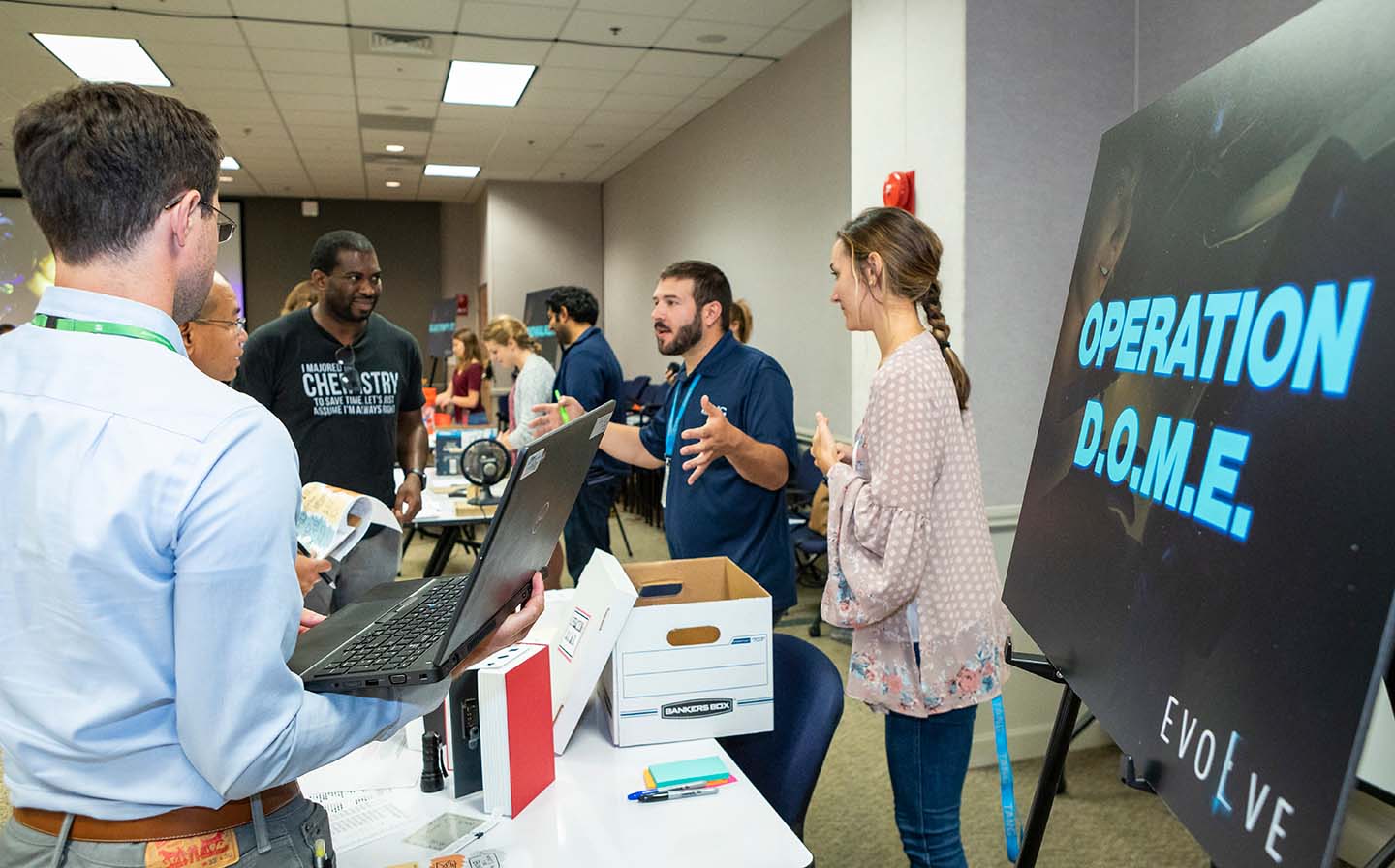Press Release
Johns Hopkins APL Teams Up with United Way for STEM Kit Challenge
The representatives from United Way fanned out among the STEM demo presentations, pens and paper in hand, questions at the ready. They queried members of the seven Johns Hopkins University Applied Physics Laboratory teams as they made their rounds.
“How does a teacher deploy this?” they asked, and “How would you relate this to the experience of inner-city children?” “What are the key learning mechanisms in this project?”
The Air and Missile Defense Sector’s (AMDS) Evolve team, which aims to inspire staff members to lead no matter their position, hosted a Future Innovators STEM Kit Demo day on July 19 at APL’s Laurel, Maryland, campus, part of the Laboratory’s ongoing partnership with the United Way of Central Maryland.
The teams demonstrated their STEM kits for United Way reps, as well as AMDS staff and interns, whose votes determined that Operation D.O.M.E. — an escape room-themed kit that requires students to solve problems and unlock clues to complete a mission — took the top honors.
“They really nailed it,” said Bruce Kranig, associate vice president of development at the United Way of Central Maryland. “When you start talking about teamwork, collaboration, leadership skills and things like that the kids can apply during the exercise, that’s fantastic.”
The United Way reps praised Operation D.O.M.E not only for an inventive, fun concept that could be used repeatedly by just changing the puzzles within, but also for its diversity of thought and subject matter, and its applicability to the workforce with a focus on hard and soft skills. Each rep also noted that the project focuses not only on science, technology, engineering and math skills, but potentially offers a history or social studies lesson, or a chance to practice reading comprehension.
It was the brainchild of the design thinking group in AMDS, a newly formed set that includes Emily Mintman, Sarah Rigsbee, Lindsay Frisvold, Matthew Gubanich, Leah Strohsnitter, Reeve Heinis, and Bruce Ballard. The project also included input from three staff members from APL’s STEM office — Jaracus Copes, Jason Cartwright and Jessica Goodard — and one from the Force Projection Sector, Christopher Covert.
“One of the unique things about our group is that we all come from various disciplines, and I think we tried to incorporate that into the box,” Mintman said. “It included a broad range of challenges that touched different areas of expertise and disciplines across STEM.”
Thinking Inside the Box
The idea came to the group after they’d played their own “escape room in a box” board game, Heinis said, and they keyed in on how it required collaboration and teamwork to get the job done. The involvement of Copes, Cartwright and Goodard helped the team focus on the P21 framework — a model for incorporating the critical skills necessary to join the 21st-century workforce.
Operation D.O.M.E. was the challenge winner, but the United Way representatives were so impressed with the work done by APL staff members that they’re considering ways to showcase all of the projects.
“A lot of groups thought about not just what the content was and how it fit into the curriculum, but what are employers looking for?” said Amy Novak, a former teacher and the United Way’s assistant director of development. “You could have a kid who has no clue what the content is but he could be a great leader and organize everything and everyone and be an integral part of that team.”
Changing Lives
When it was time to announce the winner, Dante deTablan, the vice president of the United Way Ben Center at Brooklyn/Curtis Bay, spoke emotionally about the impact the kits will have on students, sharing from his own life experience as a father.
“You’re about to change some serious lives,” he told the teams.
The kits will most likely be utilized at Ben Franklin High School, which, deTablan informed the teams, was slated for closure in 2010 with 226 students and is now a thriving educational facility for more than 500 kids, plus a waitlist.
“You’re talking about children who, if it weren’t for the generosity of the APL staff, would come to school without backpacks,” added Beth Littrell, the United Way director of community engagement and volunteerism, referencing previous APL drives for United Way. “It’s a huge deal. The main focus in a lot of high-poverty schools is going to be math and reading because it’s all about test scores. But something like this, where they have an opportunity to use their brains to do something fun and educational, it’s important. This they’ll remember.”
The next step in the challenge will be for group members to encourage their coworkers to help build as many STEM kits as possible. Each Operation D.O.M.E. kit costs $40, but the team also floated the idea of asking AMDS staff members to contribute puzzle ideas, as well. The exact number of students who will benefit from the kits depends on how much the team can gather. Given that APL typically blows past what the United Way estimates in these drives, they are facing good odds.
As she closed out the demonstration event, AMDS Operations Executive Mimi Mierzwa left the teams with a heartfelt congratulatory message.
“As a sponsor of Evolve but also as the AMDS ops executive, I couldn’t be any prouder of this sector and the people in it,” she said.
